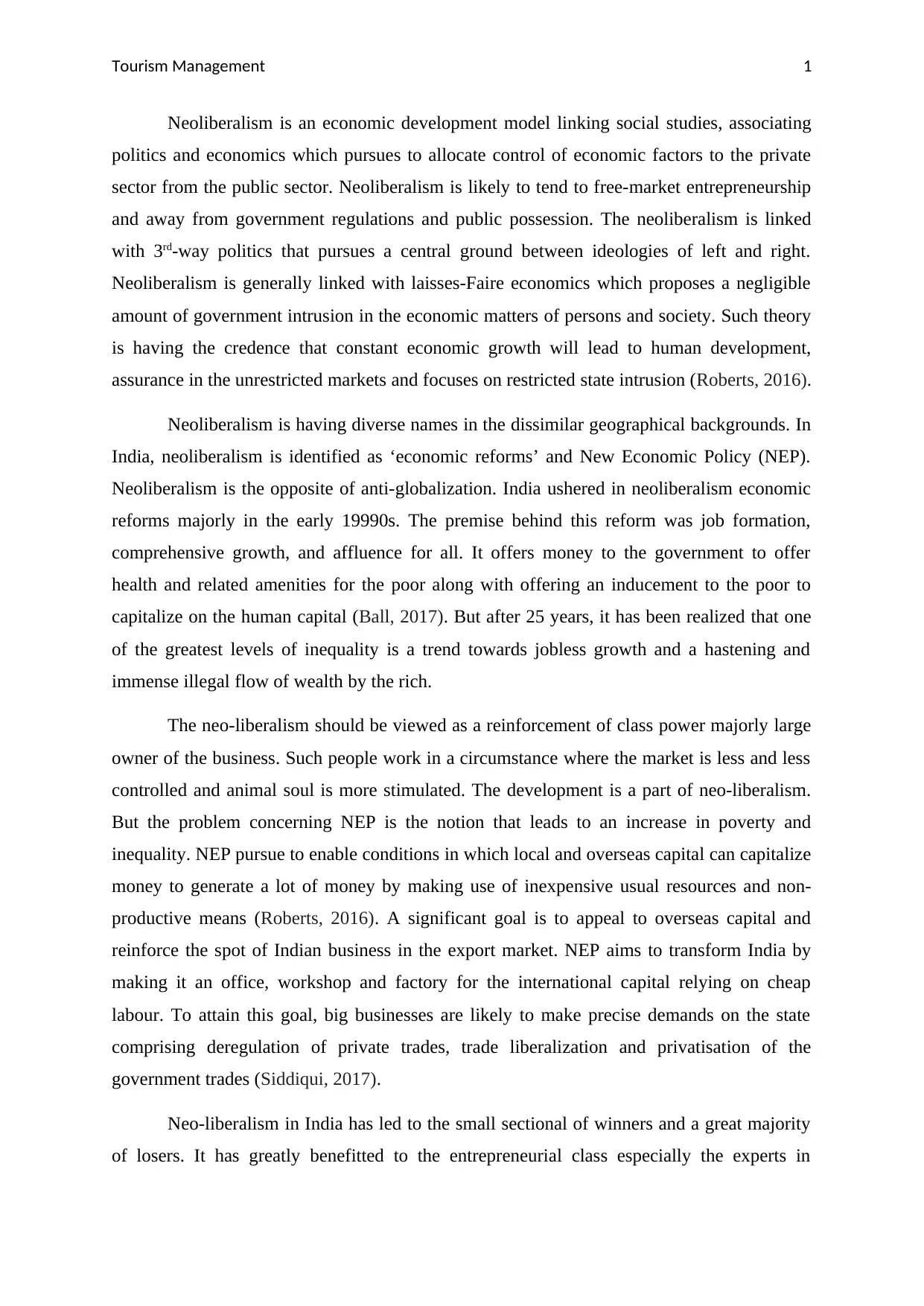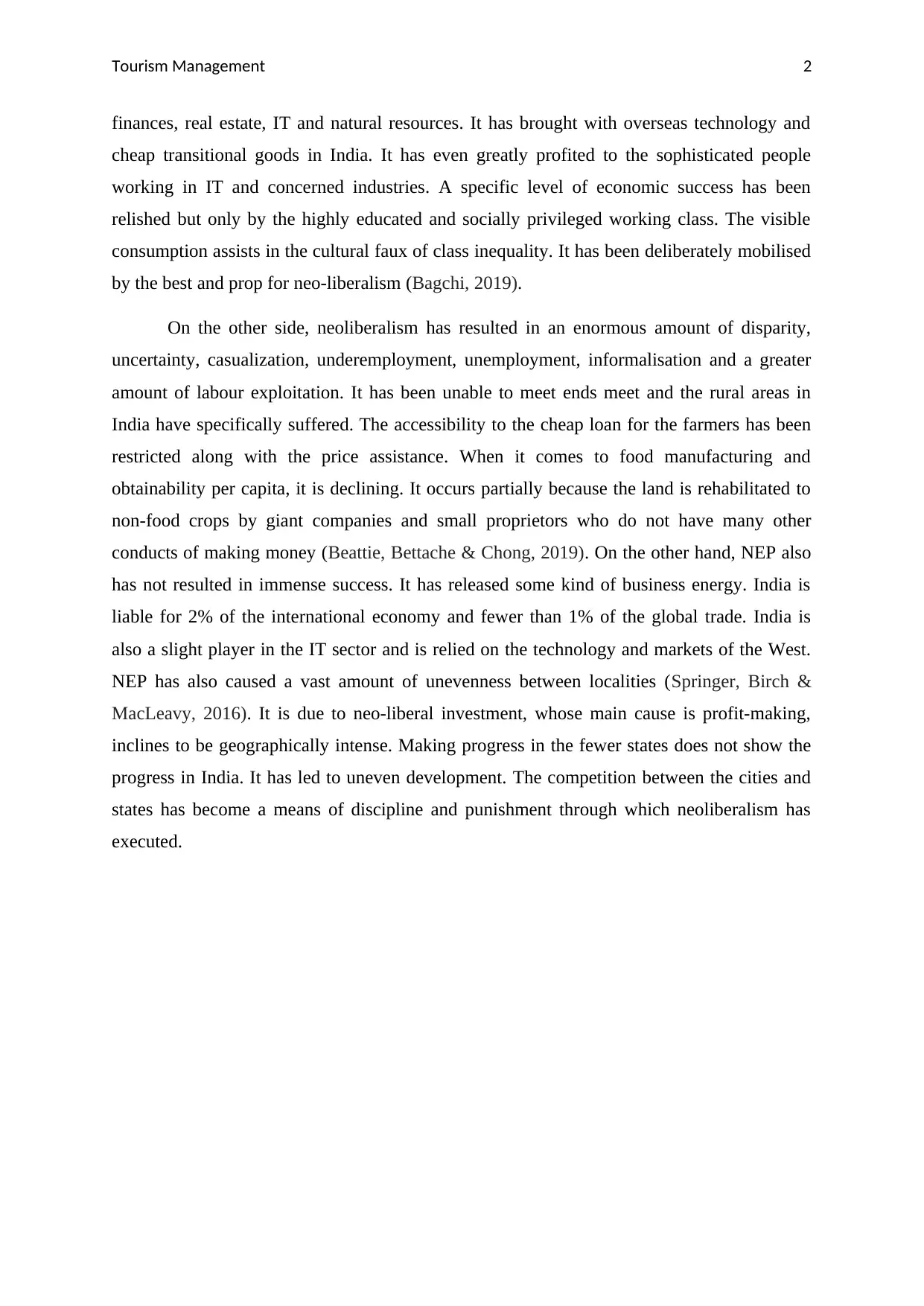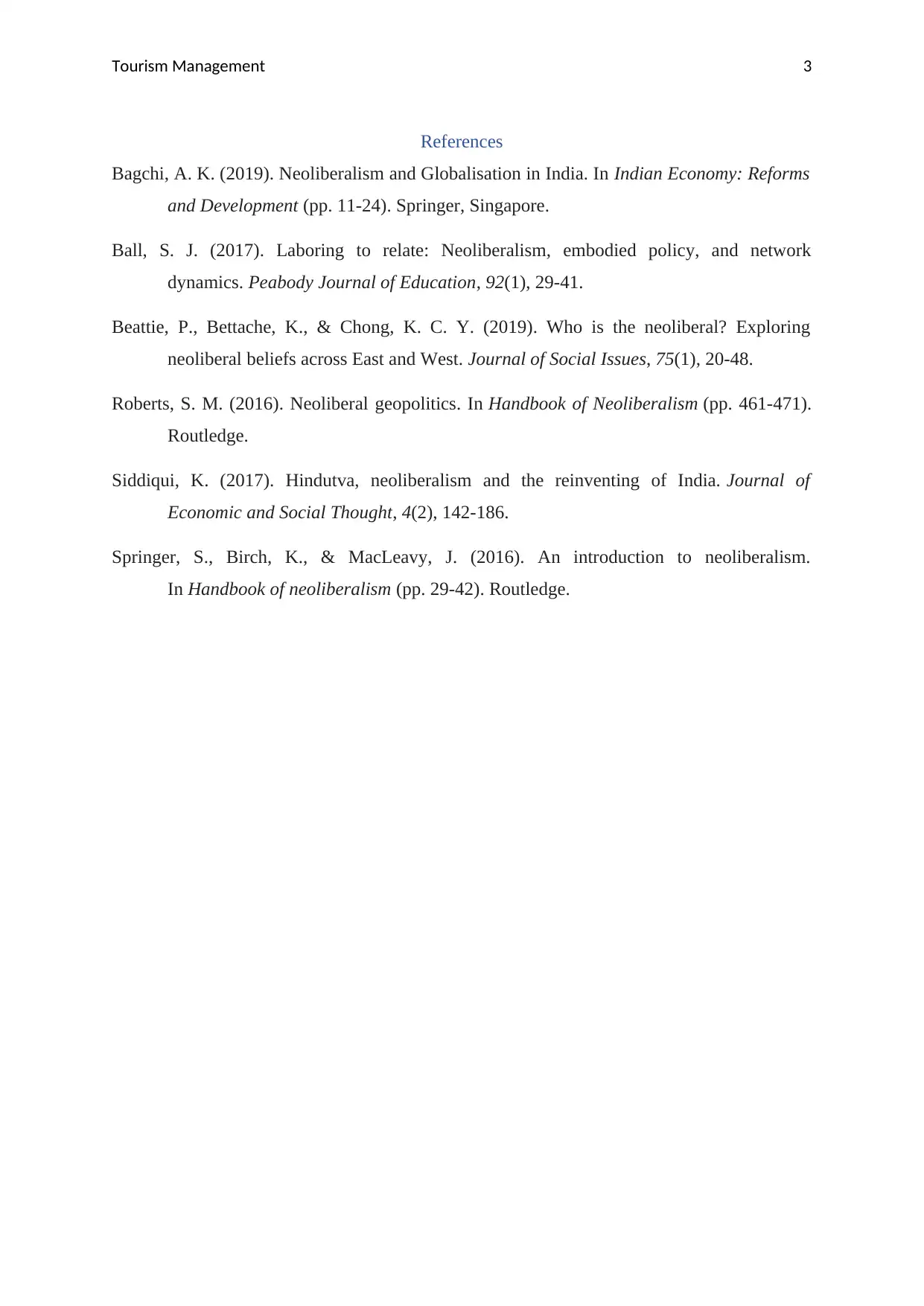Analyzing Neoliberalism's Influence on India's Development (TMGT 2060)
VerifiedAdded on 2022/08/20
|4
|1033
|11
Report
AI Summary
This report examines neoliberalism as an economic development model, focusing on its implementation in India. It outlines the core characteristics of neoliberalism, emphasizing free-market principles and reduced government intervention. The report analyzes the impact of neoliberal reforms, such as the New Economic Policy (NEP), on various aspects of Indian society, including job creation, economic growth, and income inequality. It highlights both the benefits, such as attracting foreign investment and technological advancements, and the drawbacks, including increased disparities, unemployment, and exploitation. The analysis also addresses the uneven development across different regions and the challenges to long-term sustainability. The report concludes by assessing the overall success of neoliberal policies in India, considering its global economic standing and the uneven distribution of its benefits.

Tourism Management
Paraphrase This Document
Need a fresh take? Get an instant paraphrase of this document with our AI Paraphraser

Tourism Management 1
Neoliberalism is an economic development model linking social studies, associating
politics and economics which pursues to allocate control of economic factors to the private
sector from the public sector. Neoliberalism is likely to tend to free-market entrepreneurship
and away from government regulations and public possession. The neoliberalism is linked
with 3rd-way politics that pursues a central ground between ideologies of left and right.
Neoliberalism is generally linked with laisses-Faire economics which proposes a negligible
amount of government intrusion in the economic matters of persons and society. Such theory
is having the credence that constant economic growth will lead to human development,
assurance in the unrestricted markets and focuses on restricted state intrusion (Roberts, 2016).
Neoliberalism is having diverse names in the dissimilar geographical backgrounds. In
India, neoliberalism is identified as ‘economic reforms’ and New Economic Policy (NEP).
Neoliberalism is the opposite of anti-globalization. India ushered in neoliberalism economic
reforms majorly in the early 19990s. The premise behind this reform was job formation,
comprehensive growth, and affluence for all. It offers money to the government to offer
health and related amenities for the poor along with offering an inducement to the poor to
capitalize on the human capital (Ball, 2017). But after 25 years, it has been realized that one
of the greatest levels of inequality is a trend towards jobless growth and a hastening and
immense illegal flow of wealth by the rich.
The neo-liberalism should be viewed as a reinforcement of class power majorly large
owner of the business. Such people work in a circumstance where the market is less and less
controlled and animal soul is more stimulated. The development is a part of neo-liberalism.
But the problem concerning NEP is the notion that leads to an increase in poverty and
inequality. NEP pursue to enable conditions in which local and overseas capital can capitalize
money to generate a lot of money by making use of inexpensive usual resources and non-
productive means (Roberts, 2016). A significant goal is to appeal to overseas capital and
reinforce the spot of Indian business in the export market. NEP aims to transform India by
making it an office, workshop and factory for the international capital relying on cheap
labour. To attain this goal, big businesses are likely to make precise demands on the state
comprising deregulation of private trades, trade liberalization and privatisation of the
government trades (Siddiqui, 2017).
Neo-liberalism in India has led to the small sectional of winners and a great majority
of losers. It has greatly benefitted to the entrepreneurial class especially the experts in
Neoliberalism is an economic development model linking social studies, associating
politics and economics which pursues to allocate control of economic factors to the private
sector from the public sector. Neoliberalism is likely to tend to free-market entrepreneurship
and away from government regulations and public possession. The neoliberalism is linked
with 3rd-way politics that pursues a central ground between ideologies of left and right.
Neoliberalism is generally linked with laisses-Faire economics which proposes a negligible
amount of government intrusion in the economic matters of persons and society. Such theory
is having the credence that constant economic growth will lead to human development,
assurance in the unrestricted markets and focuses on restricted state intrusion (Roberts, 2016).
Neoliberalism is having diverse names in the dissimilar geographical backgrounds. In
India, neoliberalism is identified as ‘economic reforms’ and New Economic Policy (NEP).
Neoliberalism is the opposite of anti-globalization. India ushered in neoliberalism economic
reforms majorly in the early 19990s. The premise behind this reform was job formation,
comprehensive growth, and affluence for all. It offers money to the government to offer
health and related amenities for the poor along with offering an inducement to the poor to
capitalize on the human capital (Ball, 2017). But after 25 years, it has been realized that one
of the greatest levels of inequality is a trend towards jobless growth and a hastening and
immense illegal flow of wealth by the rich.
The neo-liberalism should be viewed as a reinforcement of class power majorly large
owner of the business. Such people work in a circumstance where the market is less and less
controlled and animal soul is more stimulated. The development is a part of neo-liberalism.
But the problem concerning NEP is the notion that leads to an increase in poverty and
inequality. NEP pursue to enable conditions in which local and overseas capital can capitalize
money to generate a lot of money by making use of inexpensive usual resources and non-
productive means (Roberts, 2016). A significant goal is to appeal to overseas capital and
reinforce the spot of Indian business in the export market. NEP aims to transform India by
making it an office, workshop and factory for the international capital relying on cheap
labour. To attain this goal, big businesses are likely to make precise demands on the state
comprising deregulation of private trades, trade liberalization and privatisation of the
government trades (Siddiqui, 2017).
Neo-liberalism in India has led to the small sectional of winners and a great majority
of losers. It has greatly benefitted to the entrepreneurial class especially the experts in

Tourism Management 2
finances, real estate, IT and natural resources. It has brought with overseas technology and
cheap transitional goods in India. It has even greatly profited to the sophisticated people
working in IT and concerned industries. A specific level of economic success has been
relished but only by the highly educated and socially privileged working class. The visible
consumption assists in the cultural faux of class inequality. It has been deliberately mobilised
by the best and prop for neo-liberalism (Bagchi, 2019).
On the other side, neoliberalism has resulted in an enormous amount of disparity,
uncertainty, casualization, underemployment, unemployment, informalisation and a greater
amount of labour exploitation. It has been unable to meet ends meet and the rural areas in
India have specifically suffered. The accessibility to the cheap loan for the farmers has been
restricted along with the price assistance. When it comes to food manufacturing and
obtainability per capita, it is declining. It occurs partially because the land is rehabilitated to
non-food crops by giant companies and small proprietors who do not have many other
conducts of making money (Beattie, Bettache & Chong, 2019). On the other hand, NEP also
has not resulted in immense success. It has released some kind of business energy. India is
liable for 2% of the international economy and fewer than 1% of the global trade. India is
also a slight player in the IT sector and is relied on the technology and markets of the West.
NEP has also caused a vast amount of unevenness between localities (Springer, Birch &
MacLeavy, 2016). It is due to neo-liberal investment, whose main cause is profit-making,
inclines to be geographically intense. Making progress in the fewer states does not show the
progress in India. It has led to uneven development. The competition between the cities and
states has become a means of discipline and punishment through which neoliberalism has
executed.
finances, real estate, IT and natural resources. It has brought with overseas technology and
cheap transitional goods in India. It has even greatly profited to the sophisticated people
working in IT and concerned industries. A specific level of economic success has been
relished but only by the highly educated and socially privileged working class. The visible
consumption assists in the cultural faux of class inequality. It has been deliberately mobilised
by the best and prop for neo-liberalism (Bagchi, 2019).
On the other side, neoliberalism has resulted in an enormous amount of disparity,
uncertainty, casualization, underemployment, unemployment, informalisation and a greater
amount of labour exploitation. It has been unable to meet ends meet and the rural areas in
India have specifically suffered. The accessibility to the cheap loan for the farmers has been
restricted along with the price assistance. When it comes to food manufacturing and
obtainability per capita, it is declining. It occurs partially because the land is rehabilitated to
non-food crops by giant companies and small proprietors who do not have many other
conducts of making money (Beattie, Bettache & Chong, 2019). On the other hand, NEP also
has not resulted in immense success. It has released some kind of business energy. India is
liable for 2% of the international economy and fewer than 1% of the global trade. India is
also a slight player in the IT sector and is relied on the technology and markets of the West.
NEP has also caused a vast amount of unevenness between localities (Springer, Birch &
MacLeavy, 2016). It is due to neo-liberal investment, whose main cause is profit-making,
inclines to be geographically intense. Making progress in the fewer states does not show the
progress in India. It has led to uneven development. The competition between the cities and
states has become a means of discipline and punishment through which neoliberalism has
executed.
⊘ This is a preview!⊘
Do you want full access?
Subscribe today to unlock all pages.

Trusted by 1+ million students worldwide

Tourism Management 3
References
Bagchi, A. K. (2019). Neoliberalism and Globalisation in India. In Indian Economy: Reforms
and Development (pp. 11-24). Springer, Singapore.
Ball, S. J. (2017). Laboring to relate: Neoliberalism, embodied policy, and network
dynamics. Peabody Journal of Education, 92(1), 29-41.
Beattie, P., Bettache, K., & Chong, K. C. Y. (2019). Who is the neoliberal? Exploring
neoliberal beliefs across East and West. Journal of Social Issues, 75(1), 20-48.
Roberts, S. M. (2016). Neoliberal geopolitics. In Handbook of Neoliberalism (pp. 461-471).
Routledge.
Siddiqui, K. (2017). Hindutva, neoliberalism and the reinventing of India. Journal of
Economic and Social Thought, 4(2), 142-186.
Springer, S., Birch, K., & MacLeavy, J. (2016). An introduction to neoliberalism.
In Handbook of neoliberalism (pp. 29-42). Routledge.
References
Bagchi, A. K. (2019). Neoliberalism and Globalisation in India. In Indian Economy: Reforms
and Development (pp. 11-24). Springer, Singapore.
Ball, S. J. (2017). Laboring to relate: Neoliberalism, embodied policy, and network
dynamics. Peabody Journal of Education, 92(1), 29-41.
Beattie, P., Bettache, K., & Chong, K. C. Y. (2019). Who is the neoliberal? Exploring
neoliberal beliefs across East and West. Journal of Social Issues, 75(1), 20-48.
Roberts, S. M. (2016). Neoliberal geopolitics. In Handbook of Neoliberalism (pp. 461-471).
Routledge.
Siddiqui, K. (2017). Hindutva, neoliberalism and the reinventing of India. Journal of
Economic and Social Thought, 4(2), 142-186.
Springer, S., Birch, K., & MacLeavy, J. (2016). An introduction to neoliberalism.
In Handbook of neoliberalism (pp. 29-42). Routledge.
1 out of 4
Your All-in-One AI-Powered Toolkit for Academic Success.
+13062052269
info@desklib.com
Available 24*7 on WhatsApp / Email
![[object Object]](/_next/static/media/star-bottom.7253800d.svg)
Unlock your academic potential
Copyright © 2020–2025 A2Z Services. All Rights Reserved. Developed and managed by ZUCOL.
